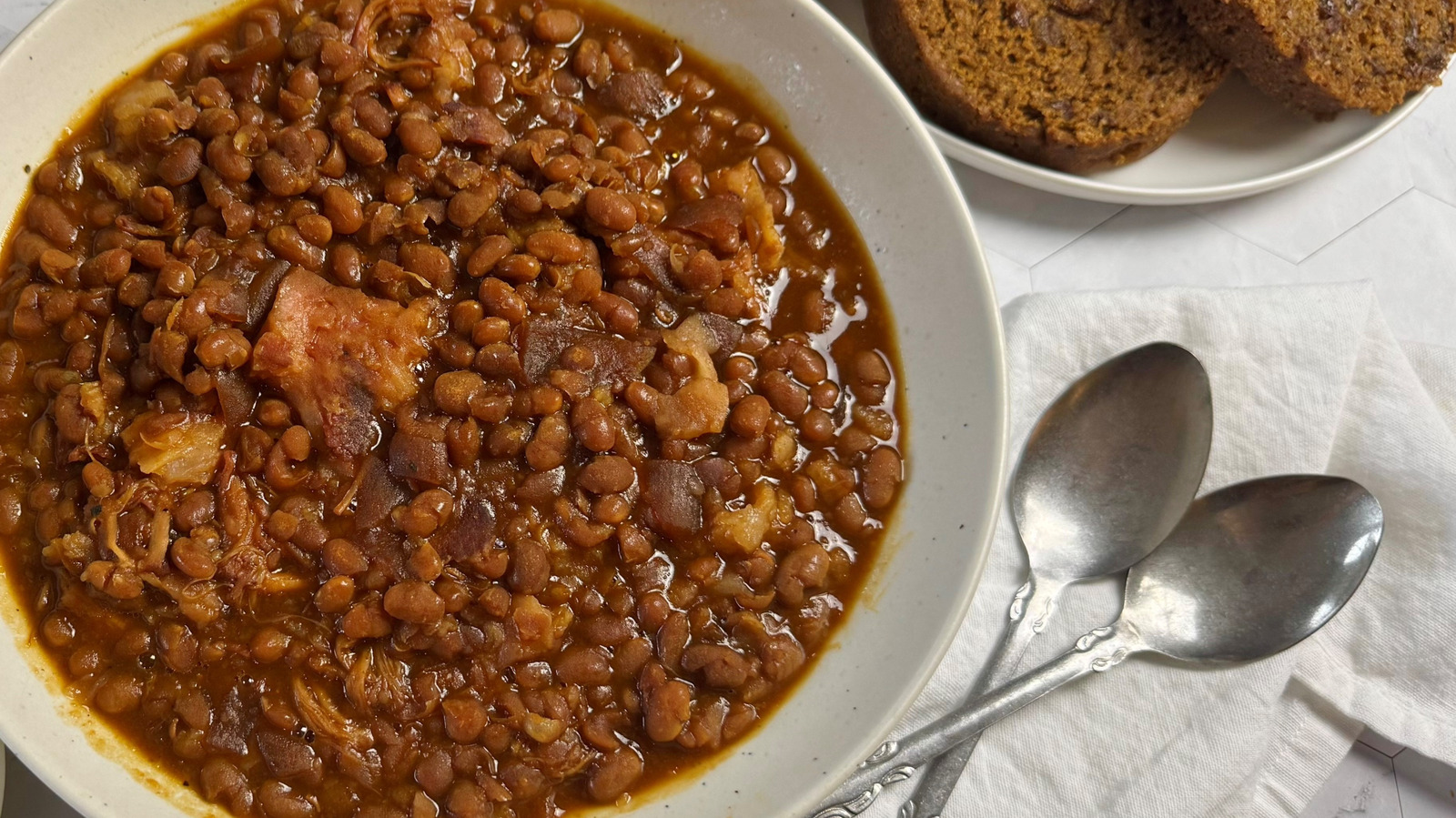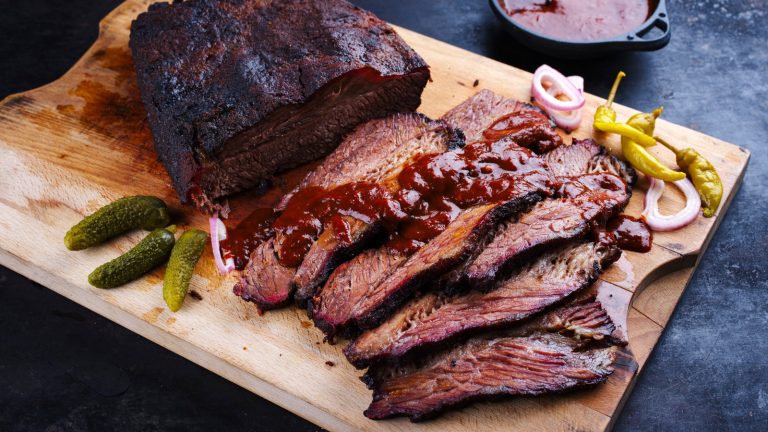Sure, you could crack open a can of baked beans and heat them in a saucepan, but canned beans pale in comparison to the deeply flavorful slow-cooked traditional version. For the real deal, Food Republic recipe developer Julianne De Witt has you covered. Her traditional Boston baked beans recipe is brimming with flavor and absolutely worth the wait.
“This is my take on the traditional recipe and it’s very close to my great-grandmother’s version from the late 1800s that has been passed down the family to me,” De Witt shares. She notes, “The recipe for Boston baked beans has been around since the 17th century when Puritans preferred a dish that they could set to cook on Saturday to eat on Sunday, saving them from having to work on the Sabbath.” Since Boston’s port was the trade site for molasses, rum, and cane sugar from the Caribbean, she adds, “Molasses was cheap and readily available so it was the natural choice to sweeten baked beans.”
As for sides to pair with this classic dish, De Witt says, “I like to serve these baked beans in the traditional way, with steamed brown bread and butter. Cornbread and coleslaw or hot dogs could also be served alongside.” Although the overall prep and cook time from start to finish is almost a day, most of that is hands-off work and requires minimal effort. Plus, this recipe makes several servings, and leftovers keep well in the fridge or freezer.
Gather the ingredients for these traditional Boston baked beans
For this recipe, you’ll need dry navy beans, kosher salt, brown sugar, salt, ground black pepper, dry mustard, cooking molasses, a small onion (diced), and salt pork.
Step 1: Add beans and water to bowl
Place the beans in a medium bowl and add cold water up to 2 inches above the top of the beans.
Step 2: Add salt and soak
Add the kosher salt and stir. Allow the beans to soak at least 12 hours overnight.
Step 3: Drain the beans
Drain the beans and add them to a large pot.
Step 4: Add beans to a pot
Add cold water to cover the beans by several inches.
Step 5: Boil and simmer
Bring the beans to a boil, then simmer for 30 minutes.
Step 6: Drain the beans
Drain the beans and reserve the bean water.
Step 7: Preheat the oven
Preheat the oven to 250 F.
Step 8: Combine sugar, seasonings, and molasses
Whisk together the brown sugar, salt, pepper, mustard, and molasses.
Step 9: Add beans and onion to pot
Layer the beans and onions in a bean pot or Dutch oven.
Step 10: Add molasses mixture
Pour the molasses mixture over the beans.
Step 11: Add bean water
Ladle in the reserved bean water to just cover the beans.
Step 12: Add salt pork
Top with the salt pork.
Step 13: Cover and bake the beans
Place the lid on the pot and put it in the oven. Bake for 5 to 6 hours until the beans are tender. Stir the beans a few times during the cooking process and add more reserved bean water if needed to prevent the beans drying out.
Step 14: Break up salt pork
Remove the lid from the pot and using tongs, break up the salt pork into smaller pieces.
Step 15: Serve the baked beans
Ladle the beans into bowls and serve.
- 1 pound dry navy beans
- 2 teaspoons kosher salt
- 2 tablespoons brown sugar
- ½ teaspoon salt
- ½ teaspoon ground black pepper
- 1 tablespoon dry mustard
- ½ cup cooking molasses
- 1 small onion, diced
- 1 pound salt pork
- Place the beans in a medium bowl and add cold water up to 2 inches above the top of the beans.
- Add the kosher salt and stir. Allow the beans to soak at least 12 hours overnight.
- Drain the beans and add them to a large pot.
- Add cold water to cover the beans by several inches.
- Bring the beans to a boil, then simmer for 30 minutes.
- Drain the beans and reserve the bean water.
- Preheat the oven to 250 F.
- Whisk together the brown sugar, salt, pepper, mustard, and molasses.
- Layer the beans and onions in a bean pot or Dutch oven.
- Pour the molasses mixture over the beans.
- Ladle in the reserved bean water to just cover the beans.
- Top with the salt pork.
- Place the lid on the pot and put it in the oven. Bake for 5 to 6 hours until the beans are tender. Stir the beans a few times during the cooking process and add more reserved bean water if needed to prevent the beans drying out.
- Remove the lid from the pot and using tongs, break up the salt pork into smaller pieces.
- Ladle the beans into bowls and serve.
Nutrition
| Calories per Serving | 924 |
| Total Fat | 62.4 g |
| Saturated Fat | 22.4 g |
| Trans Fat | 0.0 g |
| Cholesterol | 65.0 mg |
| Total Carbohydrates | 71.4 g |
| Dietary Fiber | 11.9 g |
| Total Sugars | 27.4 g |
| Sodium | 2,041.7 mg |
| Protein | 21.1 g |

What are some tips for making perfect Boston baked beans?
Although this recipe doesn’t require a whole lot of effort, it does take some time. For that reason, you’ll want to make sure the process goes smoothly so you don’t end up with subpar beans. De Witt offers some tips to ensure success. For starters, she notes, “Soaking the beans overnight cuts down on the cooking time.” It also ensures that the beans cook up with the perfect firm yet tender texture. Meanwhile, De Witt advises that you use regular molasses rather than blackstrap. “Blackstrap molasses is more intense and bitter and can overpower the flavor of the beans.”
When it comes to seasoning, De Witt recommends using a light hand with the salt. “The salt pork provides a lot of saltiness to the beans as they cook,” she notes, so you don’t want to overdo it. Finally, don’t rush the process. De Witt explains, “Cooking the beans at low temperature over several hours allows the beans to soften and creates a thick flavorful sauce, almost a glaze, without the need for added thickening ingredients such as ketchup.”
What is salt pork and what is it used for?
Salt pork is an essential ingredient for Boston baked beans, adding a rich and meaty depth of flavor: It’s more than just an ordinary cut of pork. As De Witt explains, “Salt pork is pork belly cured with salt. Salt pork looks a little like bacon but is fattier and not smoked.” Since fat carries flavor, she notes, “It’s primarily used to flavor food like beans, soups, and greens.”
If you can’t find salt pork, you could sub in bacon or pancetta. Bacon will add smokiness (which you might actually want in the dish), while pancetta will be pretty similar to the original. Meanwhile, although salt pork adds layers of umami, you can skip it if you’re trying to make this dish vegan or vegetarian. Instead, you could incorporate a bit of umami and saltiness with soy sauce, mushrooms, or miso paste.





